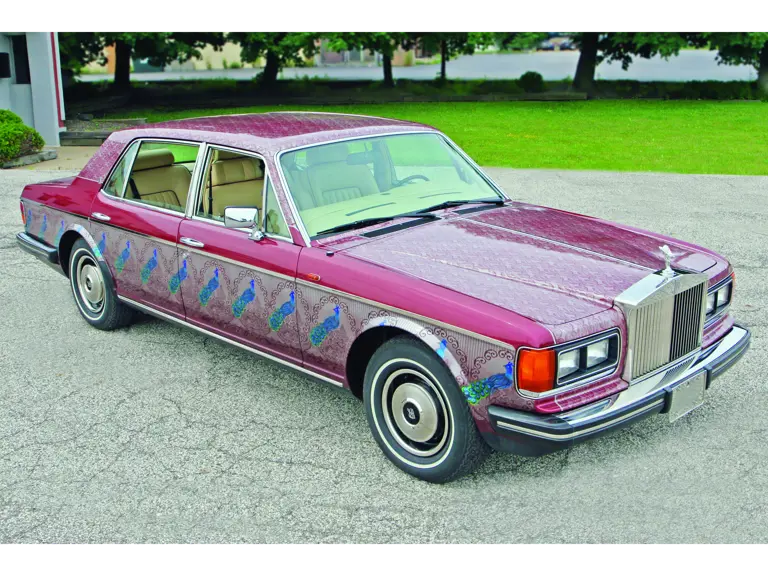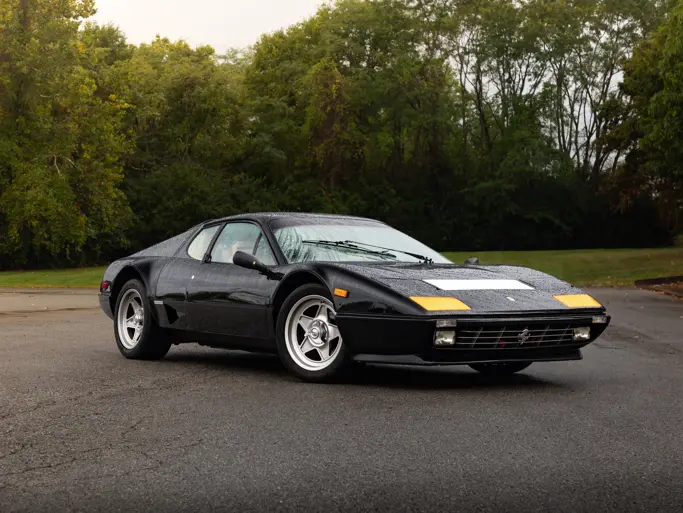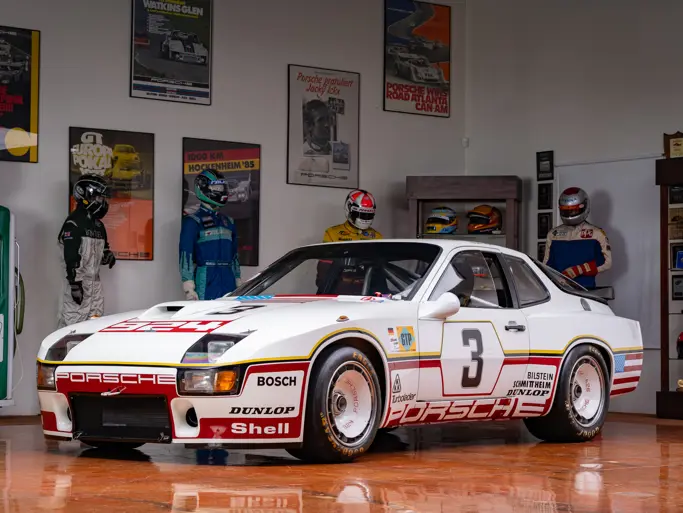
1984 Rolls-Royce Silver Spur "Lace Peacock"
{{lr.item.text}}
$30,800 USD | Sold
{{bidding.lot.reserveStatusFormatted}}
- 6.75-liter V-8 engine
- Automatic transmission
- Hand-painted for Bhagwan Shree Rajneesh
- The Bhagwan had fleet of nearly 100 "Rollers"
- Well chronicled national/international story
- Reported in original condition
- Period Rolls-Royce standards & luxuries
- Intricate "Lace Peacock" presentation
This Silver Spur is one of the 80 late model Rolls-Royces acquired by the Bhagwan Shree Rajneesh and later seized from his Oregon compound in 1985 from his then-well-known “Rajneesh Modern Car Trust Collection.” It was driven by the Bhagwan within the compound to bestow blessings to his followers. This example is reported as “immaculate” and totally original with approximately 10,000 miles on the odometer. It has been hand-painted by the Bhagwan's special artists and dubbed the Lace Peacock car. It has been meticulously maintained in excellent original condition with perfect custom cream leather interior with red piping and carpets. The Bhagwan made sure that none in his fleet would be boring and had them enveloped in eccentric custom themes that, in the case of the “Lace Peacock,” are intricately detailed. The 6.75-liter V-8 engine and automatic transmission propels this rolling artwork down the road in period luxury.
For comprehensive information about the Bhagwan’s story, please read the following article - courtesy of the owner:
A Fresh Look at the Oregon Bhagwan and His Rolls-Royces
By Terry V. Boyce (US Michigan)
Three decades have passed since the Bhagwan Shree Rajneesh quit his much-disputed Oregon commune and left the U.S. forever. He left behind more than 80 late-model Rolls-Royces from his famous “Rajneesh Modern Car Trust Collection.” Row upon row of mainly Silver Spirits and Spurs would look utterly boring—were it not for the custom paint schemes many of them sported. Among the most memorable was the 1984 Silver Spur “Lace Peacock Car.” It survives today in virtually as-new condition, and serves us here as a featured representative of the Rajneesh collection. Its history is interwoven with the stranger-than-fiction saga of the Bhagwan’s ultimately failed attempt to build a U.S. center for his global Rajneesh Foundation International.
To many westerners, the bushy-bearded Bhagwan seemed a “campy” guru of the sort stereotyped in too many Hollywood farces—at least until one looked into his piercing eyes. Seekers of enlightenment who followed his path saw him as a benign and endearing leader, and many supported him with all of their energies and wherewithal. It remains open to debate as to whether or not the Bhagwan endorsed—or was even aware of—his immediate staff’s notorious criminal machinations.
Who was this venerated guru with nearly 100 Rolls-Royces at his beck-and-call? Chandra Mohan Jain was born in central India on December 11, 1931. The first-born of his parents’ eleven offspring, he was known even as a child by the nickname “Rajneesh.”
Having found “enlightenment” at age 21, Rajneesh was by 1958 a professor of philosophy at a small university. He became a popular author and widely traveled speaker who encouraged a “live in the moment” approach to spiritual matters. In the late 1960s, he was labeled “the sex guru” by the Indian press, due to his calls for more open attitudes to sexuality. (He would later note that only two of the 300 books he’d written were dedicated to the inflammatory topic.).
In 1971 the budding guru began calling himself the Bhagwan Shree Rajneesh—which might be loosely translated as, “The revered and esteemed Rajneesh.” He established his original Ashram in Poona (now Pune) India during 1974. There, he made his 150-yard commute to work in a chauffeur-driven Mercedes-Benz—until it was replaced by a Rolls-Royce in 1979.
After a would-be assassin injured the Bhagwan in 1980, followers ordered a stretched and armored Silver Wraith II limousine for his use. Specialists in Florida lengthened the car and added its “Level Five” armor. To insure the Bhagwan would be pleased, the $302,500 rolling fortress was then treated to a lavish full-custom interior.
In mid-1981, a group of Rajneesh followers, led by the Bhagwan’s personal secretary, 31-year-old Ma Anand Sheela, left India for the U.S. to seek out a suitable location for a massive new headquarters, from which the guru’s extensive global operations could be run. The Bhagwan—and his armored Wraith II—followed that August.
Inconveniently, shortly before leaving India, Rajneesh had taken a self-imposed vow of silence—he wouldn’t start talking again (with only a very few exceptions) until late 1984!
The Bhagwan chose a remote 100-square-mile tract of near-desert land, located about 150 miles southeast of Portland, Oregon, for his new commune. The Rajneeshees—as his followers were collectively known—paid $5.75 million for the former Big Muddy Ranch and renamed it Rancho Rajneesh.
In between their morning meditations and disco nights, the Rajneeshees accomplished much. Within a year, numerous new buildings, roads, and even a small airport had sprouted on the ranch. A reservoir that would enable the Rajneeshees to make the property into a veritable oasis in the arid region was also created. The bustling community was eventually awarded legal status as a small city. Named “Rajneeshpuram,” it was assigned a zip code by the U.S. Postal Service. At its peak, the commune would be home to thousands of the red-clad followers of the guru.
The Wraith II was soon joined by additional Rolls-Royces at the ranch. “We enjoyed it so much—and he enjoyed them so much—(that) we just kept on buying him cars,” a Rajneeshee later told a journalist. “We were aiming for 365—why not get him one for every day of the year?” The delighted Bhagwan relished the thought of amassing the largest collection of Rolls-Royce motorcars ever assembled.
Before long, two new Rolls-Royces were being added to the Bhagwan’s stable every month. About 15 of the earliest cars were channeled to Rajneeshpuram through the franchised Rolls-Royce dealer in Portland. Dealers from across the U.S. were called upon for cars when specific models or colors couldn’t be sourced there. At least one, and probably more, of the new cars were delivered directly from the factory to the Rajneesh Modern Car Trust Collection. The Rajneeshee buyers sometimes settled for lightly used near-new models to keep the monthly flow of vehicles coming. Tough negotiators, they usually paid close to invoice—and almost always settling up with payment in full.
As Rolls-Royce was shipping around 1,100 cars a year to America in the early 1980s, the Bhagwan single-handedly represented more than 2 percent of the company’s U.S. sales in the early 1980s!
Coming up with the money needed for the Bhagwan’s monthly Rolls-Royce additions required astute planning on the part of his financial people. Early on, a number of the expensive luxury cars were donated by sannyasins (followers) as gifts. Others were funded through complicated leasing schemes that essentially amounted to sponsorships. Two wealthy disciples leased multiple Rolls-Royce from the commune—and then immediately donated them back, for the Bhagwan's exclusive use. Three seemingly lucky followers were awarded a Rolls-Royce in $20-per-ticket raffles, but each of the prize cars somehow remained in the Bhagwan’s collection.
Details are murky, but after the newly formed Rajneesh Modern Car Trust Collection took over control of the cars in late 1982, more cars were apparently bought outright.
During the first months at the commune, the Bhagwan regularly drove alone on public roads, followed by guards in a GMC Suburban. The robustness of the armored Wraith II may have saved his life during one such ride. The driver of a concrete truck that struck the big limo while the Bhagwan was at the wheel was later quoted as saying, “By God, I never saw a truck bounce off a car before.”
Later, as tensions with local citizens increased and threats of violence against the Bhagwan and his Rajneeshees became commonplace, the daily Rolls-Royce exercise routine was confined to the ranch. Each afternoon, the Bhagwan would glide serenely along the communal roads in that day’s favored car, proceeding at a walking pace as he waved at crowds of adoring followers.
The Rolls-Royces were strictly for the Bhagwan’s use. Only the West German mechanic who ran the commune’s maintenance facility was otherwise authorized to drive them. Occasionally, Rolls-Royce technicians were summoned to provide certified service.
A body shop, outfitted and equipped for custom paintwork, was established. Multiple reports state that 36 of the more than 90 Rolls-Royces acquired for the Bhagwan’s exclusive use were turned out with special paint and decoration by Rajneeshpuram’s artists.
Some of the Rajneeshees applying their talents to customizing the Bhagwan’s cars seem to have been more grounded in Southern California trends than in Indian tradition. Gold metal flake and psychedelic purples were reportedly applied to some of the stately cars. Interiors were often enhanced with inset jewels, gold knobs, lace curtains and “hanging cotton balls.”
Going in a completely different direction, several of the Rolls-Royces were artistically graced with intricate lace graphics on their body sides, hood, top and trunk. One lace car was further decorated with “kimono” paintings by a Japanese artist follower. Another was adorned by a Swami artist with colorful peacocks, set into painted panels along its body sides. That car; Silver Spur chassis no. ECX09382, was immediately dubbed “the Lace Peacock Car.” The intricacies of its special paintwork can be examined in the photos accompanying this article.
The peacock is the esteemed national bird of India, and the Lace Peacock Car was undoubtedly laden with meaning and symbolism to the Rajneesh and those sannyasins who were also natives of that country. Hundreds of the colorful birds lived at Rancho Rajneesh during the years of the commune.
Rolls-Royce motorcars also hold a special and enduring place in Indian history. According to the manufacturer, the Maharajahs and Princes of India purchased more than 840 Rolls-Royces during “the golden age of the Raj”—a period that in the automotive context existed from about 1907 to the abolishment of the princely states in1947. A fair number of the Indian potentate’s bespoke super luxury cars were fitted with custom touches of extraordinary richness that gave the cars a distinctly Indian character. (In 2014, Rolls-Royce Motor Cars honored this grand legacy with an ultra-exclusive bespoke “Maharajah” Phantom Drophead Coupé that included representations of the peacock in its Carrara White exterior detailing and within the stunning interior).
Open cars were not favored at Rajneeshpuram, however. The Bhagwan preferred Silver Spur saloons. After he started talking again, he revealed that chronic back pain had caused him to favor the model. “I have used all cars, best in the world; but the seat of just one car, one of the models of Rolls-Royce, the Silver Spur, fits with me perfectly. It is not their costliest car; their costliest is the Corniche . . . I tried a Corniche, it didn't work—my back trouble started. But with the Silver Spur it has settled completely,” he told a reporter.
While the Bhagwan had pondered in silence the colors and décor he wanted for his Silver Spurs, his commune’s future had slowly but surely unraveled. His Rajneeshee executive team’s confrontations with local and regional authorities over land use issues were endless.
Not helping at all was the increasingly bombastic and confrontational attitude displayed by Sheela, who served as the Bhagwan’s chief of staff at the commune. For three years, she managed the Rajneeshee operations and—with the Bhagwan’s silent and unquestioning backing—represented the commune in public affairs. Her verbal battles with government officials were legendary. “She seemed to spit insults with every breath,” a reporter later recalled.
Frustrated by numerous failed attempts to secure the commune’s future legally, Sheela and a secret group of administrators conspired to commit a series of win-at-any-cost criminal acts during 1984. Incidents of arson occurred, and a plot to murder the U.S. Attorney in Oregon was averted only by circumstances. The Bhagwan’s personal doctor narrowly escaped being killed by one of the plotters.
The most infamous act actually carried out by the co-conspirators was a mass food poisoning that involved multiple restaurants—the intent being to keep anti-cult voters at home during a critical county election. The poisoning sickened more than 700 persons and is still considered the largest act of bio-terrorism in U.S. history.
Even as the commune’s financial troubles mounted and legal woes multiplied, the Bhagwan continued to receive his monthly ration of new Rolls-Royces. Our featured Silver Spur arrived during November 1984. By that time, cartoonist Berke Breathed was lampooning the Bhagwan in his wildly popular “Bloom County” comic strip.
The situation at Rajneeshpuram deteriorated rapidly during 1985, as accusations began to fly. Anticipating arrest, Sheela resigned and temporarily fled to Europe. The Bhagwan seemed genuinely shocked when he learned of the criminal acts she and other members of the secret inner-circle group had allegedly committed. Speaking at the ranch for the first time to his gathered followers, he strongly denied prior knowledge of the miscreant’s deeds. He urged the sannyasins to be truthful in their statements about what had transpired.
Following intensive investigations by local, state, and Federal authorities at the commune, Sheela was charged with multiple felonies. She would serve more than two years in a Federal prison. After her release, she moved to Switzerland.
The Bhagwan was brought up on only two relatively minor charges, both relating to immigration fraud. He avoided trial by essentially pleading no-contest and accepting a deal that included deportation and a $400,000 fine. He soon departed the U.S. for a “world tour.” After 21 countries reportedly refused him residency, he returned to India. It is said that he was permitted to keep ten of the Rolls-Royces from his Oregon collection, and the number remaining at the ranch in late 1985 was indeed so reduced. However, the author has been unable to find anything about the ten cars’ eventual disposition.
With the departure of the Bhagwan, Rajneeshpuram rapidly disintegrated. The Rolls-Royces that remained there—along with everything else that had been part of life at Rajneeshpuram—were immediately put up for sale. After inspecting the collection, an offer to buy the cars en masse was made by 39-year-old Texas collector-dealer Robert “Bob” Roethlisberger and his attorney partner. (The total number of Rolls-Royces included in the lot is variously reported to have been 83 or 85 cars; we believe 85 to be correct).
On November 25, 1985, Roethlisberger flew into Rajneeshpuram by private jet to seal the deal—reportedly with cash. A spokesperson for the new owners’ Texas-based European Auto Group later said they paid between “$5 and $6 million” for the cars.
According to a 2012 Oregon Public Broadcasting documentary film, the proceeds from the sale of the Rolls-Royces was “distributed to sannyasins on the ranch so they would have some money to start a new life.”
Heavy snow was falling at Rajneeshpuram when a fleet of twelve car haulers arrived to load the cars for their journey to Texas. The move reportedly cost $200,000. Four Rajneeshees were employed by the European Auto Group to help administer the resale of the Rolls-Royces.
Roethlisberger reportedly considered offering all of the Bhagwan cars at auction, but changed his mind after collectors showed “heavy interest.” Still, he took eight of the Bhagwan cars to a Boca Raton, Florida auction.
One of the Rolls-Royces consigned to the February 16, 1986 Boca Raton auction was the “Lace Peacock” car, and it created quite a stir there. A local newspaper reporter described the scene: “Photographers, television cameramen and reporters crowded the 1984 Silver Spur Rolls-Royce with Oregon plates. Spectators also pushed in closely, trying to catch a glimpse of ‘the Peacock Car,’” the reporter wrote. A follow-up story reported that four of the eight ex-Bhagwan Rolls-Royces were sold to high bidder at the auction, but that the Peacock Car had been a no-sale.
Documentation accompanying the Lace Peacock Car to this day indicates it was sold outright to a collector on February 14—the date of the Friday auction “preview” preceding the Sunday auction. Ownership was conveyed at that time to the new owner, an Ohio collector. The original Oregon title, still in the name of the Rajneesh Modern Car Trust Collection accompanied the car — and remains with it today.
Tragically, Roethlisberger died of cancer on April 23, 1986, just two weeks after his 40th birthday. Obituaries published in several newspapers reported that 43 of the Bhagwan Rolls-Royces had by then been sold, “at prices ranging from $65,000 to $100,000.”
Later that year, NBC’s “Saturday Night Live” featured a skit in which comedian Randy Quaid parodied a Florida auctioneer selling off Rolls-Royces formerly owned by the Bhagwan. (More recently, an episode of FOX network’s “The Simpsons” included a satiric segment featuring an animated Bhagwan driving a Rolls-Royce amidst fawning followers.)
After adapting OSHO as a new name, the guru formerly known as Rajneesh set about re-establishing his prominence. Heart failure cut short his efforts at age 59. His epitaph reads, “OSHO – Never Born, Never Died. Only Visited this Planet Earth between Dec 11 1931– Jan 19 1990.” A global network of independently operated OSHO mediation centers and resorts continue to espouse his teachings today.


 | Auburn, Indiana
| Auburn, Indiana


